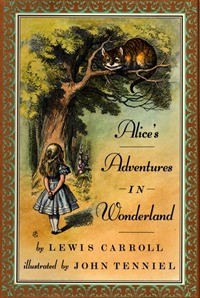Alice’s Adventures in Wonderland by Lewis Carrol

What’s down the rabbit hole?
A hot summer’s day on the riverbank, and young Alice is bored. Bored, that is, until a white rabbit in a checked jacket scurries past in a great hurry, examining a pocket watch. Burning with curiosity, Alice can’t help but follow the rabbit down the hole which leads to a long passageway – and a tiny door too small to get through.
So begins Alice’s adventures in the amazing world of Wonderland. In the pages that follow a strange liquid will shrink her to only ten inches tall; a curious cake will disappear before her eyes; a mad hatter will invite her to tea – and Alice will play a very dangerous game of croquet…
The character of Alice is based on Alice Liddell, the ten-year-old daughter of an academic at Christ Church College in Oxford, where author Lewis Carroll studied and taught. Carroll would tell Alice stories to entertain her: Alice begged him to write them out and he presented them to her in 1864. He was later persuaded to publish and, after further additions, the book as we know it today appeared in 1865, including the famous illustrations by John Tenniel.
Alice in Wonderland was Lewis Carroll’s first novel and its fantasy plot, humorous rhymes and brilliant use of nonsense was revolutionary. Nineteenth-century children’s writing usually served moral or educational purpose, but Alice was written firmly and purely for the amusement of children. Critical response was lukewarm, but the book was still a great success, and remains a hugely influential classic of children’s literature.
Alice appeals to adults as well as children and over the years readers and critics have found within it all manner of riddles, puzzles, mathematical concepts and references to Carroll’s famous and not-so-famous friends.
Lewis Carroll was the pen-name of Charles Lutwidge Dodgson, born in 1832 in Cheshire in the north of England. His father, the local rector, came from a family of distinguished scholars and clergymen. Dodgson continued the academic family tradition and studied mathematics and theology, eventually becoming a mathematician at Oxford University.
He first began to write comic poetry and prose in the 1850s and had several pieces published in magazines, where he first began to use the name Lewis Carroll. In 1856 he met four-year-old Alice Liddell who was to inspire the book which made Dodgson’s name, Alice’s Adventures in Wonderland, published in 1865. The book was an immediate success, was translated into many languages and soon established itself as an English classic. Its sequel, Through the Looking-Glass, appeared in 1871. Their revolutionary combination of word-play, humour and nonsense had never been seen before in writing for children. His other great masterpiece of nonsense is the poem The Hunting of the Snark (1876), and other books for children including Phantasmagoria (1869) and Sylvie and Bruno (1889).
Charles Dodgson never married and remained at Oxford all his adult life, where he wrote several books on mathematics and logic as well as devising board games and brainteasers. He was also an expert photographer, famous for his portraits of children and many artistic personalities of the day. He died in 1898.
This Alice’s Adventures in Wonderland book review was written byMS Nirupama X D

Akbar Birbal Stories
By : Karthik Menon
Akbar Birbal Stories
Author:
Monisha Mukundan
Illustrator:
Tapas Guha
Rupa Publications,
1992
This is a review of a book called Akbar Birbal Stories by Monisha Mukundan which I read in the summer holidays. The book is a lot of fun. It is a book about the great emperor Akbar and his loyal advisor Birbal. If you read this book you will learn a lot about the ways in which Birbal tackled his problems set for him by Akbar. You can also learn a lot of new ways to solve your own problems by reading this book. In all the stories there is something to learn. And you don’t always get the same lesson in every chapter.
There are ten stories in the book. The stories are not too long, about two to four pages each. So if you are uninterested in reading long stories, you should surely read this book. This book has been written by a very successful writer called Monisha Mukandan. She has written four books like this and this is her fifth. The book also has a lot of good illustrations so that young readers do not get bored. The illustrations are by Tapas Guha. But the pictures are not very colourful. They only have two colours. It is very strange reading a book with illustrations in black and blue. In all the stories there is a happy ending.
This book should be praised because the author describes the problems very seriously and also describes how Birbal solves his problems effortlessly. In one of the stories Birbal had to solve a murder. Nobody knew who the murderer was and everybody accused an innocent man. Even with the odds against him Birbal did not give- up and he proved the innocence of the accused person. This is one of my favourite stories in the book.
The book is set in the times of the Mughals. The writer describes the landscape very beautifully. She has described the events very well. The language is not very difficult to understand. The writer has used very nice and uncommon words to describe the places and the people in this book. The book on the whole is very attractive in its looks. The picture on the cover is very colourful. And there is also a small summary of the book at the back. I would end my review by saying that all the stories in this book are not true but they contain a great deal of truth in them. So next time you go to a bookshop do not forget to buy this book.
POORNIMA is a Class VII B student at KV ARMY AREA PUNE 40i.
























